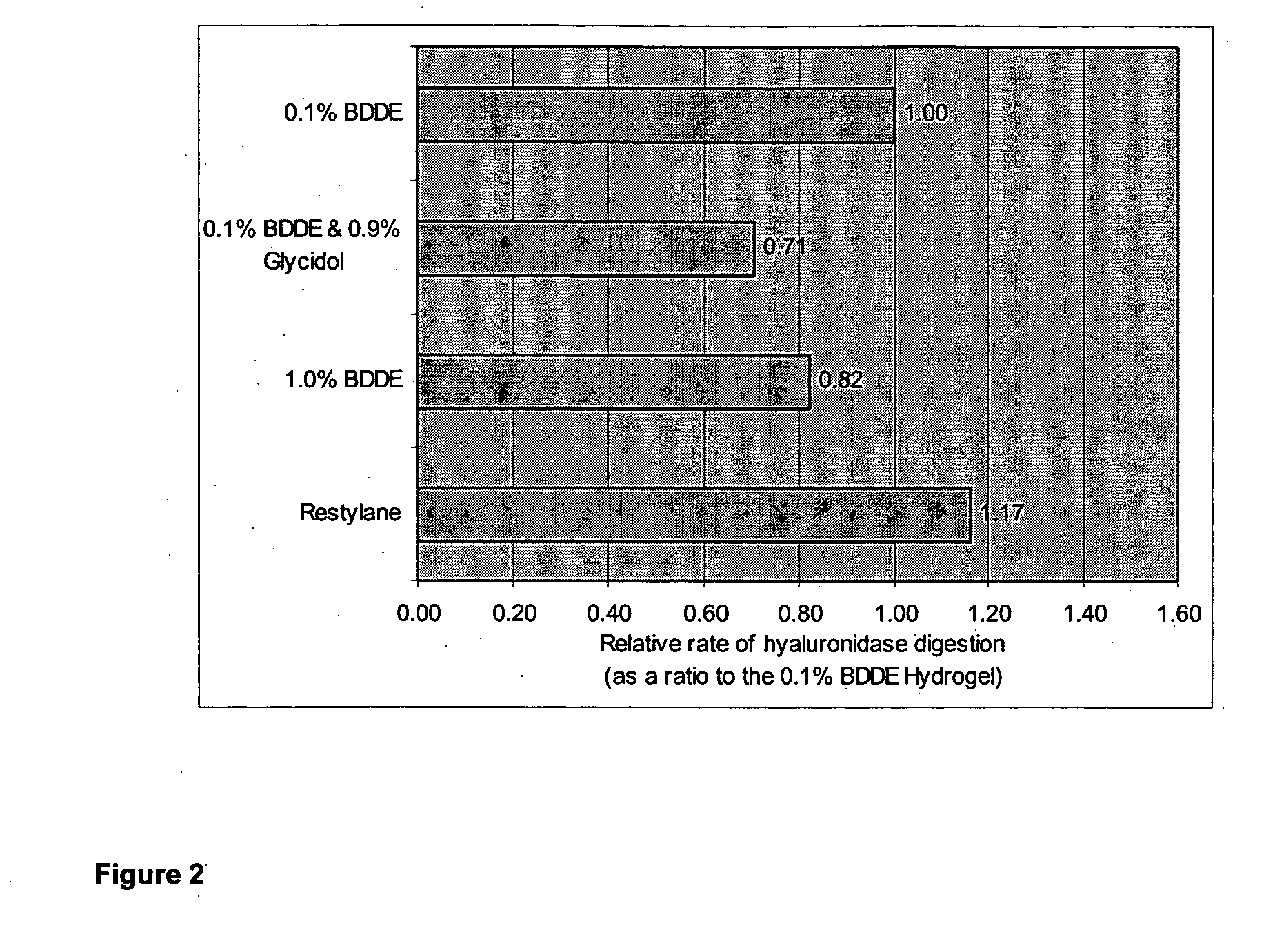Cross-linked polysaccharide gels
a polysaccharide gel and cross-linked technology, applied in the preparation of sugar derivatives, biocides, sugar derivatives, etc., can solve the problems of extraordinarily high turnover rate of vertebrate tissues, poor biomechanical properties, and inability to develop new biomaterials, so as to improve the degradation characteristics of cross-linked polysaccharide gels and reduce immunogenicity
- Summary
- Abstract
- Description
- Claims
- Application Information
AI Technical Summary
Benefits of technology
Problems solved by technology
Method used
Image
Examples
example 1
0.075% BDDE Cross-Linked HA Hydrogel Preparation
[0058]Sample of powder hyaluronic acid [Fluka from Streptococcus equi (MW 1.69 MD)] (4.00 g) was dissolved in 1% NaOH (100 ml) with vigorous stirring over a period of 60 minutes at 40° C., 1,4-Butanediol diglycidyl ether (BDDE; 75.0 μl, 0.376 mmol) in THF (425.0 μl) was then added with vigorous stirring and stirring continued for 45 minutes at 40° C. The solution was then dried under high vacuum (30 mbar) for 1.0 hour at 40° C. with slow rotation until weight=7.32 g.
[0059]The resulting transparent polysaccharide matrix was rehydrated with acetic acid in water (2.6% v / v; 100 ml) for 20 minutes and the gel was slowly lifted from the glass edges during this time. The pH of the fully swollen gel at the end of this process had been neutralized. Isopropyl alcohol (200 ml) was then added to the gel and the gel Was left to stand for a further 45 minutes with swirling. The IPA / H2O mixture was decanted off and the gel partially rehydrated with H...
example 2
0.075% BDDE Cross-Linked HA Hydrogel With 0.1052% Glycidol
[0066]A sample of powdered hyaluronic acid [Fluka from Streptococcus equi (MW 1.69 MD)] (4.00 g) was dissolved in 1% NaOH (100 ml) with vigorous stirring over a period of 60 minutes at 40° C. 1,4-Butanediol diglycidyl ether (BDDE; 75.0 μl, 0.376 mmol) and Glycidol (105.2 μl, 1.520 mmol) together in THF (319.8 μl) was then added with vigorous stirring and stirring continued for 45 minutes at 40° C. The solution was then dried under high vacuum (30 mbar) for 1.0 hours at 40° C. with slow rotation until weight=7.43 g.
[0067]The resulting transparent polysaccharide matrix was rehydrated with acetic acid in water (2.6% v / v; 100 ml) for 20 minutes and the gel was slowly lifted from the glass edges during this time. The pH of the fully swollen gel at the end of this process had been neutralized. Isopropyl alcohol (200 ml) was then added to the gel and the gel was left to stand for a further 45 minutes with swirling. The IPA / H2O mixtu...
example 3
0.1% BDDE HA Hydrogel Preparation
[0072]A sample of soluble powdered sodium hyaluronate [Fluka from Streptococcus equi (MW 1.69 MD)] (2.0000 g) was dissolved in a solution of 1% w / v NaOH (50 ml) by mixing with vigorous stirring over a period of 20 minutes at 40° C. Fresh 1,4-butanediol diglycidyl ether (BDDE; 47.9 mg, 0.225 mmol) was then added dropwise and the solution was stirred for 20 minutes at 40° C. The solution was then dried under vacuum for 30 minutes at 40° C. whilst rotating the reaction flask. During this time the evaporation was carefully manipulated such that the body of viscous liquid was deposited evenly over the inside surface of the barrel of reaction flask used. This was continued until the total weight of the H2O in the reaction was approximately equal to that of the original weight of HA.
[0073]The resulting polysaccharide matrix was left to stand for 20 minutes in the dry state at room temperature. The gel was then partially rehydrated and neutralized. with acet...
PUM
| Property | Measurement | Unit |
|---|---|---|
| temperature | aaaaa | aaaaa |
| temperature | aaaaa | aaaaa |
| half life | aaaaa | aaaaa |
Abstract
Description
Claims
Application Information
 Login to View More
Login to View More - R&D
- Intellectual Property
- Life Sciences
- Materials
- Tech Scout
- Unparalleled Data Quality
- Higher Quality Content
- 60% Fewer Hallucinations
Browse by: Latest US Patents, China's latest patents, Technical Efficacy Thesaurus, Application Domain, Technology Topic, Popular Technical Reports.
© 2025 PatSnap. All rights reserved.Legal|Privacy policy|Modern Slavery Act Transparency Statement|Sitemap|About US| Contact US: help@patsnap.com



